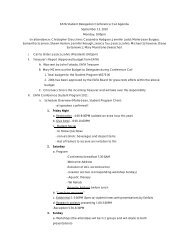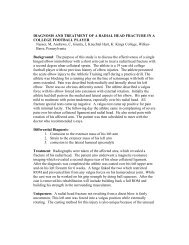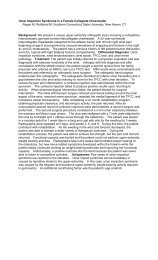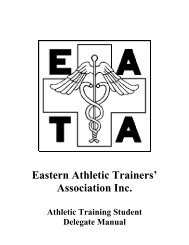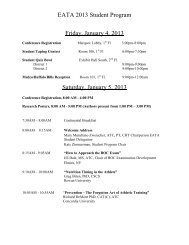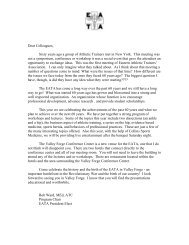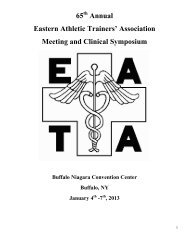Overhead Squat Assessment
Overhead Squat Assessment
Overhead Squat Assessment
You also want an ePaper? Increase the reach of your titles
YUMPU automatically turns print PDFs into web optimized ePapers that Google loves.
Practical Application for Athletic Trainers<br />
M. Susan Guyer, DPE, ATC, CSCS, CES
Which one?<br />
NASM - CES<br />
FMS<br />
SFMA
<strong>Assessment</strong><br />
The NASM - OHS assessment is the<br />
quickest and easiest to perform at the<br />
start of the sport season.<br />
Information obtained can be used to<br />
tailor pre-habilitation programs<br />
specifically to the needs of each<br />
individual athlete.<br />
A word about prevention!
Primary Movements<br />
Two Primary Movement <strong>Assessment</strong>:<br />
• NASM-CES<br />
○ <strong>Overhead</strong> <strong>Squat</strong><br />
○ Single-leg <strong>Squat</strong><br />
Dynamic <strong>Assessment</strong> (other)<br />
• Single-leg Step Off<br />
• Functional Movement
Rational - OHS<br />
The OHS assesses<br />
• total body structural alignment<br />
• dynamic flexibility<br />
• and neuromuscular control from a bilateral standing posture.<br />
<strong>Squat</strong>ting requires optimal motion in the ankles,<br />
knees, and hips.<br />
Having the arms elevated overhead<br />
• stresses the musculature surrounding the shoulder complex<br />
• increases the demand placed upon the core stabilizing<br />
muscles.
Rational - OHS<br />
To perform the OHS correctly without<br />
compensation in structural alignment,<br />
one must demonstrate:<br />
• optimal and bilaterally symmetrical dynamic<br />
range of motion at each joint (length-tension<br />
relationships)<br />
• optimal force-couple relationship (proper<br />
recruitment strategies).
Practicality<br />
<br />
<br />
<br />
Once compensations are found we will be able to<br />
tell:<br />
Probable overactive muscles<br />
• Inhibit/Lengthen<br />
• Flexibility Exercises will be used<br />
○ Self-Myofascial Release (SMR)<br />
○ Static Stretching<br />
○ Neuromuscular Stretching<br />
Probable underactive muscles<br />
• Activate/Integrate<br />
• Strengthening exercise will be used<br />
○ Positional Isometrics<br />
○ Isolated strengthening<br />
○ Integrated Dynamic Movement
Corrective Exercise<br />
Continuum<br />
Inhibit Lengthen Activate Integrate
Kinetic Chain Checkpoints<br />
Foot/Ankle<br />
Knee<br />
Lumbo-Pelvic-Hip<br />
Compels (LPHC)<br />
Shoulder and Cervical<br />
Spine (Upper Body)
<strong>Overhead</strong> <strong>Squat</strong> <strong>Assessment</strong><br />
Anterior Lateral Posterior
Set-up<br />
Feet straight ahead<br />
Shoulder width apart<br />
Arms raised above<br />
their head as shown
Procedures<br />
Perform a series of<br />
squats 5 times per<br />
view<br />
<strong>Squat</strong> to the depth of<br />
an average chair<br />
height
Anterior View<br />
<br />
<br />
<br />
Kinematic check points<br />
• Feet<br />
• Knees<br />
Feet<br />
• Should be straight ahead,<br />
2 nd metatarsal of each foot<br />
should be parallel to one<br />
another<br />
Knees<br />
• Knees move inward<br />
• Knees move outward
Anterior View<br />
View<br />
Anterior<br />
Checkpoint Compensation<br />
Probable Over-active<br />
Muscle<br />
Feet Turn Out Soleus<br />
Lat. Gastrocnemius<br />
Biceps Femoris<br />
Tensor Fascia Lata (TFL)<br />
Knees Move Inward Adductor Complex<br />
Bicep Femoris (short<br />
head)<br />
TFL<br />
Lat. Gastrocnemius<br />
Vastus Lateralis<br />
Move Outward<br />
Piriformis<br />
Biceps Femoris<br />
TFL<br />
Gluteus Medius Gluteus<br />
Minimus<br />
Probable Under-active<br />
Muscle<br />
Med. Gastrocnemius<br />
Med. Hamstring<br />
Gluteus<br />
Medius/Maximus<br />
Gracilis<br />
Popliteus<br />
Med. Hamstring<br />
Med. Gastrocnemius<br />
Vastus Medialis (VMO)<br />
Adductor Complex<br />
Med. Hamstring<br />
Gluteus Maximus
Lateral View<br />
Two main Checkpoints<br />
• LPHC<br />
○ Excessive forward Lean<br />
○ Back Rounds<br />
○ Back Arches<br />
• Upper body<br />
○ Arms fall forward
Lateral View – Excessive Forward Lean
Lateral View<br />
View<br />
Checkpoint Compensation Probable Overactive Muscle Probable Under-active Muscle<br />
Lateral<br />
Upper Body Arms Fall Forward Latissimus Dorsi<br />
Pectoralis Major/Minor<br />
Coracobrachialis<br />
LPHC<br />
Excessive Forward<br />
Lean<br />
Low Back Arches<br />
Soleus<br />
Gastrocnemius<br />
Hip Flexor complex<br />
Hip Flexor Complex<br />
Erector Spinae<br />
Latissimus Dorsi<br />
Mid/Lower Trapezium<br />
Rhomboids<br />
Posterior Deltoid<br />
Rotator Cuff<br />
Anterior Tibialis<br />
Gluteus Maximus<br />
Erector Spinae<br />
Gluteus Maximus<br />
Intrinsic Core Stabilizers<br />
Low Back Rounds<br />
Hamstrings<br />
Adducor magnus<br />
Rectus Abdominis<br />
External Obliques<br />
Gluteus Maximus<br />
Erector Spine<br />
Intrinsic Core Stabilizers
Posterior View<br />
Check Points<br />
• Feet<br />
○ Flatten<br />
○ Heels Rise<br />
• LPHC<br />
○ Asymmetrical Weight<br />
Shift
Posterior View<br />
View<br />
Posterior<br />
Checkpoint Compensation Probable Overactive<br />
Muscle<br />
Feet Flatten Peroneal Complex<br />
Toe extensor complex<br />
Lat. Gastrocnemius<br />
Biceps Femoris<br />
TFL<br />
Heel Rise<br />
Soleus<br />
Gastrocnemius<br />
Probable Under<br />
active Muscle<br />
Posterior Tibialis<br />
Anterior Tibialis<br />
Med. Gastrocnemius<br />
Gluteus Medius<br />
Anterior Tibialis<br />
LPHC<br />
Asymmetrical<br />
Weight Shift<br />
Adductor Complex (on<br />
same side of shift)<br />
TFL<br />
Piriformis<br />
Bicep Femoris<br />
Gluteus Medius (on<br />
opposite side of shift)<br />
Gluteus Medius (on<br />
side of shift)<br />
Adductor Complex<br />
(on opposite side<br />
of shift)
OHS Modifications<br />
Heals raised<br />
Hands on Hips
Rational - SLS<br />
Assesses lower body dynamic flexibility and<br />
neuromuscular control as well as balance form a<br />
unilateral standing position.<br />
Provides a grater challenge to the LPHC as the<br />
base of support for the body has been reduced.<br />
This forces the core and the priprioception<br />
mechanism to work harder.<br />
Also assesses functionally applicable movements<br />
used in everyday activities.
Single-Leg <strong>Squat</strong> <strong>Assessment</strong><br />
Starting Position<br />
• Feet straight ahead<br />
• Shoulder width apart<br />
• Hands on hip<br />
• Shift weight to one leg<br />
Procedures<br />
• 3 squats with hands on<br />
hips<br />
• Comfortable depth
LPHC – Hip Hike/Hip Drop<br />
<br />
<br />
<br />
Pelvis should remain level<br />
in the frontal plane<br />
LPHC- Hip Hike or drop<br />
Knee goes valgus
Single-Leg Step Off<br />
Added to OHS and SLS as a dynamic<br />
evaluation of biomechanics and<br />
function.<br />
Most knee injuries occur in the valgus<br />
knee position.
Right leg step off
Left leg step off
Functional Movement Scale<br />
Designed to evaluate athletic movement<br />
of agility, power, speed and functional<br />
strength<br />
• No validity or reliability data as of date
Test<br />
Standing long jump<br />
Vertical jump
Standig LJ
Standing LJ
Most Common Findings<br />
Excessive forward lean (weak intrinsic<br />
core)<br />
Knee Valgus with single leg stance<br />
(weak gluteal region/poor balance)<br />
Foot Pronation (anterior/posterior tibialis<br />
imbalance)<br />
Heel Rises (overactive soleus)<br />
Correction with heal elevation (LPHC)<br />
Erect landing (poor technique)
Excessive Forward Lean (Lateral<br />
View)<br />
Overactive<br />
• Gastrocnemius<br />
• Soleus<br />
• Hip Flexor Complex<br />
• Abdominal Complex<br />
○ Rectus abdominis<br />
and External Oblique<br />
Underactive<br />
• Anterior Tibialis<br />
• Gluteus Maximus<br />
• Erector Spinae<br />
• Intrinsic Core<br />
Stabilizers
Sample Corrective Exercise Program for Excessive Forward Lean<br />
Phase Modality Muscles(s) Acute Variables<br />
Inhibit SMR Gastrocnemius/soleus<br />
Hip flexor Complex<br />
(TFL/rectus femoris)<br />
Lengthen<br />
Activate<br />
Integrate<br />
Static Stretching<br />
or NMS<br />
Positional<br />
Isometrics and/or<br />
Isolated<br />
Strengthening<br />
Integrated<br />
Dynamic<br />
Movement<br />
Gastrocnemius/soleus<br />
Hip flexor Complex<br />
Gluteus Maximus<br />
Core stabilizers<br />
Ball Wall <strong>Squat</strong><br />
Hold on tender<br />
area of 30<br />
seconds<br />
30-sec hold or 7-<br />
10 sec. isometric<br />
contract, 30 sec.<br />
hold<br />
4 reps or<br />
increasing<br />
intensity 25, 50,<br />
75, 100% OR<br />
10-15 reps with<br />
2 sec. isometric<br />
hold and 4<br />
second eccentric<br />
10-15 reps<br />
under control
Knee Valgus<br />
Found on Anterior View
Foot Pronation<br />
Found on Posterior View
Heel Rises<br />
Found on Posterior View
Conclusion<br />
Movement assessments are the<br />
cornerstone of an integrated<br />
assessment process<br />
Used to observe the length-tension<br />
relationship, force-couple relationships,<br />
and joint motions of the entire kinetic<br />
chain.<br />
This process is only part of the<br />
assessment we perform on the athletic<br />
prior to competing.
References<br />
NASM – CES Movement <strong>Assessment</strong><br />
NCAA – ISS data




